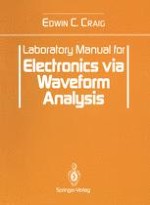To the Instructor The purpose of this laboratory manual is not just to help students to set up electronic circuits that function as they should. The important thing is the electronic concepts that the student learns in the process of setting up and studying these circuits. Quite often a student learns more electronics when he has to trouble shoot a circuit than when the circuit performs as it should when first built. It is unlikely that any students would be able to complete all of these experiments in one semester. The author believes that all students should have laboratory experiences with power sup plies, amplifiers, oscillators, and integrated circuits. Additionallabomtory experiments should be de termined by the instructor. Therefore, you can choose those that you want done. Some students are more efficient in the labomtory than others. Therefore, some would be able to complete more exper iments in a semester than others. Also many of these experiments cannot be completed in one two hour laboratory period. If space is available, the circuits could be left intact from one period to the next. Or you might want to select steps in an experiment that you want to delete. Neither the val ues of the components or the magnitudes of the power supplies, as given in the instructions, are critical. Therefore you could in most cases change them if the ones recommended are not available.
